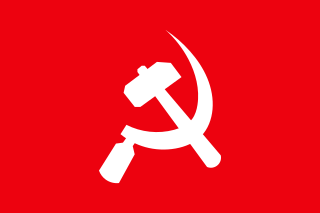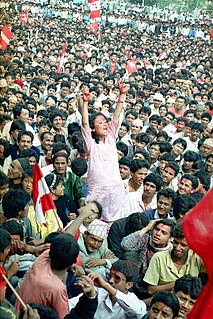
The Communist Party of Nepal (Marxist–Leninist–Maoist), abbreviated CPN (MLM), was a minor communist party in Nepal. The party was as founded in 1981 by Krishna Das Shrestha. Initially known as the Nepal Marxist-Leninist Party, Shrestha had broken away from the Bagmati District Committee, which functioned semiautnomously, of the Communist Party of Nepal in 1969. Krishna Das Shrestha was the party president.

The Communist Party of Nepal (Marxist) was a Nepalese political party. It was formed on 1 November 1991 by a group of former leaders of the original Communist Party of Nepal (Marxist) that had been expelled from the Communist Party of Nepal. Initially, it was known as the Communist Party of Nepal but took the name Communist Party of Nepal (Marxist) after approximately one year of existence. Prabhunaryan Chaudhary was the chairman of the party.

The Nepal Workers and Peasants Party (NMKP), also known as the Nepal Majdoor Kisan Party and abbreviated Nemkipa, is a political party in Nepal. The party was founded on 23 January 1975 by Narayan Man Bijukchhe and enjoys most of its support from Bhaktapur. The party is sympathetic to the Workers' Party of Korea and Juche.

The Communist Party of Nepal was a communist party in Nepal. CPN (UC) was formed on 19–20 November 1990 through the merger of Communist Party of Nepal (Mashal), Communist Party of Nepal, Proletarian Workers Organisation, and Communist Party of Nepal (Janamukhi). Soon thereafter, a group led by Baburam Bhattarai and Shital Kumar, who had left Communist Party of Nepal (Masal), joined the party. Samyukta Janamorcha Nepal was set up as the open mass front of the party.

The Communist Party of Nepal (Masal) was a communist party in Nepal. CPN (Masal) was formed in 1983, following a split in the Communist Party of Nepal. The party was led by Mohan Bikram Singh.

The Communist Party of Nepal (Marxist–Leninist) was a political party in Nepal. It was launched in 1978 by the All Nepal Communist Revolutionary Coordination Committee (Marxist–Leninist), which founded by groups involved in the Jhapa movement. The CPN (ML) published Varg-Sangarsh and Mukti Morcha.

United National People's Movement was a coalition of Communist Party of Nepal (Mashal), Communist Party of Nepal (Masal), Nepal Marxist-Leninist Party, Proletarian Labour Organisation, Nepal Communist League and the Nand Kumar Prasai faction during the popular uprising of 1990. UNPM was created in opposition to the United Left Front, arguing that the ULF-Nepali Congress had sold out the protest movement in making compromises with the regime. UNPM called for a Constituent Assembly.

The 1990 People's Movement was a multiparty movement in Nepal that brought an end to absolute monarchy and the beginning of constitutional monarchy. It also eliminated the Panchayat system.
Nepal Revolutionary Organisation (Marxist–Leninist) was a communist organisation in Morang, Nepal. The group emerged around 1973, and was one of several local radical communist factions that surged in this period in Nepal. Madhav Kumar Nepal was the leader of the group.
Ruplal Bishvakarma was a Nepalese communist politician, peasant leader and Dalit activist. Ruplal hailed from a middle peasant family in the Chitwan district. Something of an oddity amongst Nepalese communist leaders.
Barre Sangarsh Samuha was a communist faction in Barre, Nepal. The group emerged in the early 1980s, after breaking off from the Communist Party of Nepal. It subsequently merged into the Communist Party of Nepal (Marxist-Leninist).
Nepal Workers and Peasants Organisation was a communist group in Nepal, led by D.P. Singh. It was formed when the Nepal Workers and Peasants Organisation of Hareram Sharma was divided into two.
Revolutionary Communist Organising Committee was a communist group in Nepal. The organ of the group was Rato Jhanda. The group was sometimes known as the Rato Jhanda group. The group had its origins in the faction led by Bharat Mohan Adhikari in the early 1970s, which was formed by a section of the Eastern Koshi Provincial Committee of the Communist Party of Nepal and a small splinter section of the Gandaki-based Marxist-Leninist Revolutionary Communist Party. However, this tendency had been deserted by Bharat Mohan, when he joined the Central Nucleus. Before constituting itself as the Revolutionary Communist Organising Committee, the group was called the Red Flag District Committee.
Sandesh Samuha was a communist group in Nepal. It emerged as the Dang District Committee of the Communist Party of Nepal separated itself from its mother party.
Revolutionary Communist Organisation, Nepal was a communist faction in Nepal. The group operated in the Bagmati, Janakpur and Koshi zones. The group publish Vargyuddha.
In 1992, in a situation of economic crisis and chaos in Nepal, with spiralling prices as a result of implementation of changes in policy of the new Congress government, far-left groups stepped up their political agitation. A Joint People's Agitation Committee was set up together by the Communist Party of Nepal, Samyukta Jana Morcha, Communist Party of Nepal (Masal), the Nepal Communist League and the Communist Party of Nepal (Marxist-Leninist-Maoist). The committee called for a general strike on April 6.

The United People's Front of Nepal, abbreviated SJM, was the front of the Communist Party of Nepal, or CPN (UC).
Krishna Das Shrestha is a Nepalese politician who broke away from the Bagmati District Committee - which functioned semi-autonomously - of the Communist Party of Nepal in 1969 to found the Communist Party of Nepal (Marxist–Leninist–Maoist) in 1981. Shrestha was the party president.
The Revolutionary Internationalist Movement (RIM) was an international communist organization founded in France in March 1984 by 17 various Maoist organisations around the world. It sought to "struggle for the formation of a Communist International of a new type, based on Marxism–Leninism–Maoism". The RIM appears to be defunct as are many of the founding organisations and many changed their names over the years, or have dropped active armed struggle.

Communism in Nepal traces its roots back to the pro-democracy movement of 1951, and the subsequent overthrow of the autocratic Rana regime and the establishment of democracy in Nepal. The communist movement in Nepal has split into factions multiple times and multiple factions have come together into a single fold at times as well. It has a history of getting banned from open political discourse; as well as multiple instances of embracing guerrilla insurgency, most notably, the Maoist insurgency in the 1990s and early 2000s that led to the Nepalese Civil War, claiming at least 17,000 lives. After the Maoists and other main political parties formed a united coalition, launching a successful peaceful civil resistance against the dictatorial coup d'état by the monarchy, which resulted in the abolition of the monarchy and drafting of a new constitution affirming Nepal as a secular, federal, democratic republic striving towards democratic socialism, the two main communist parties of Nepal contested the first election according to the new constitution as a coalition, eventually leading to the unification of two parties with a strong majority in the federal parliament as well as six out of seven provinces of Nepal.



